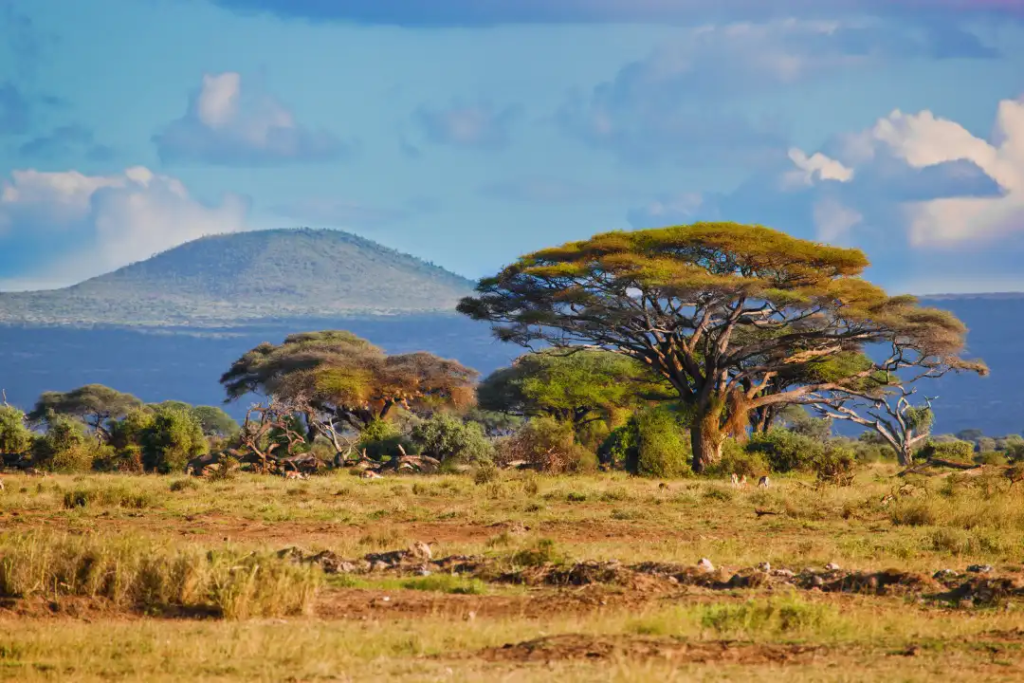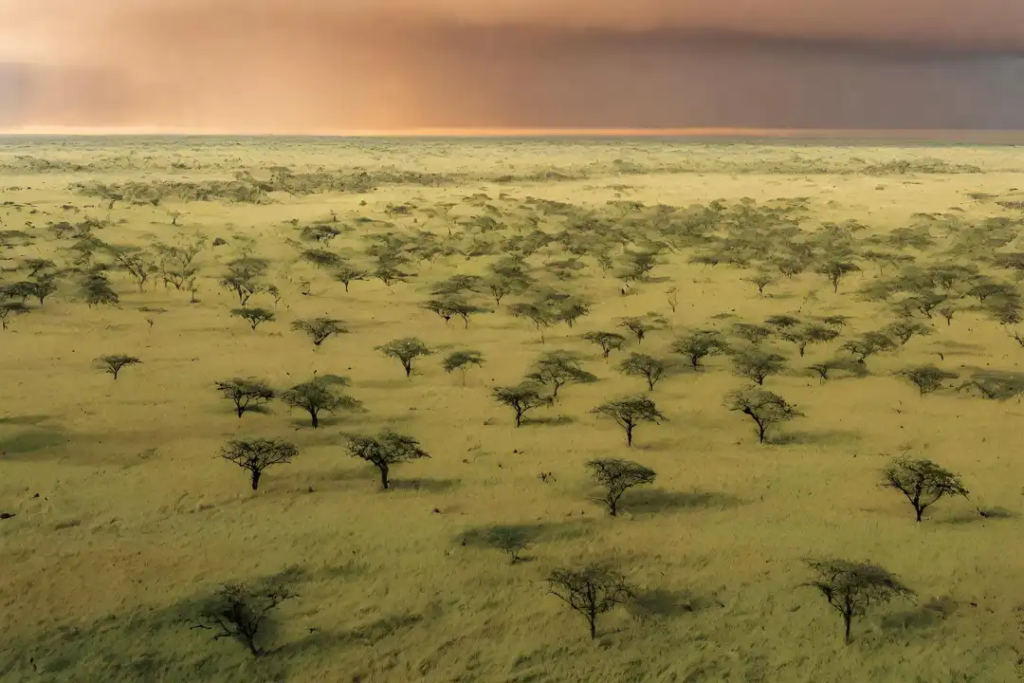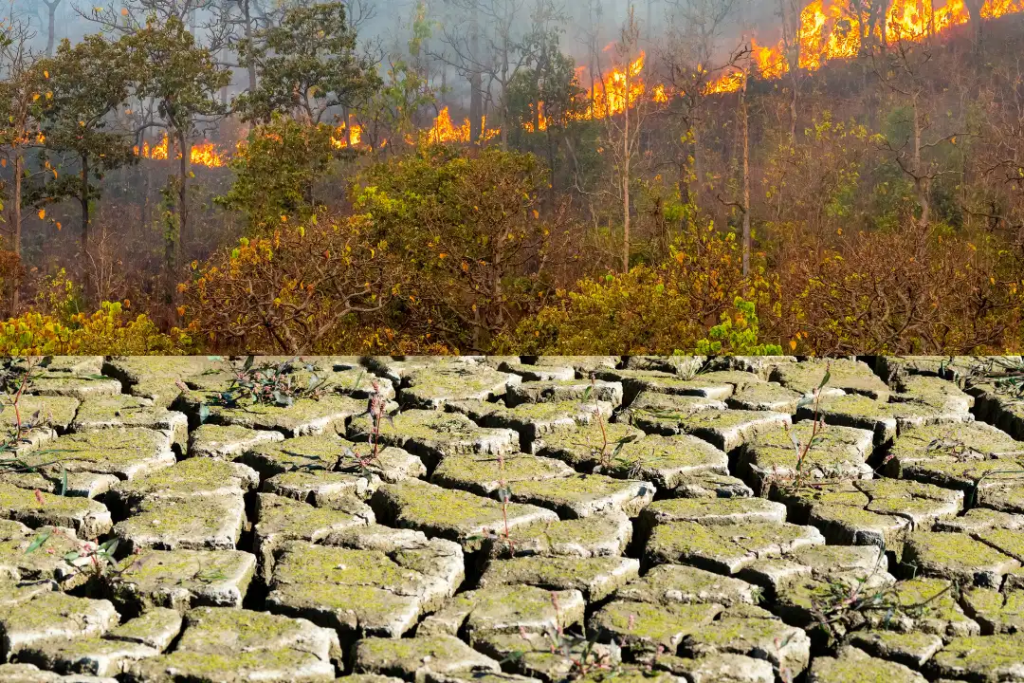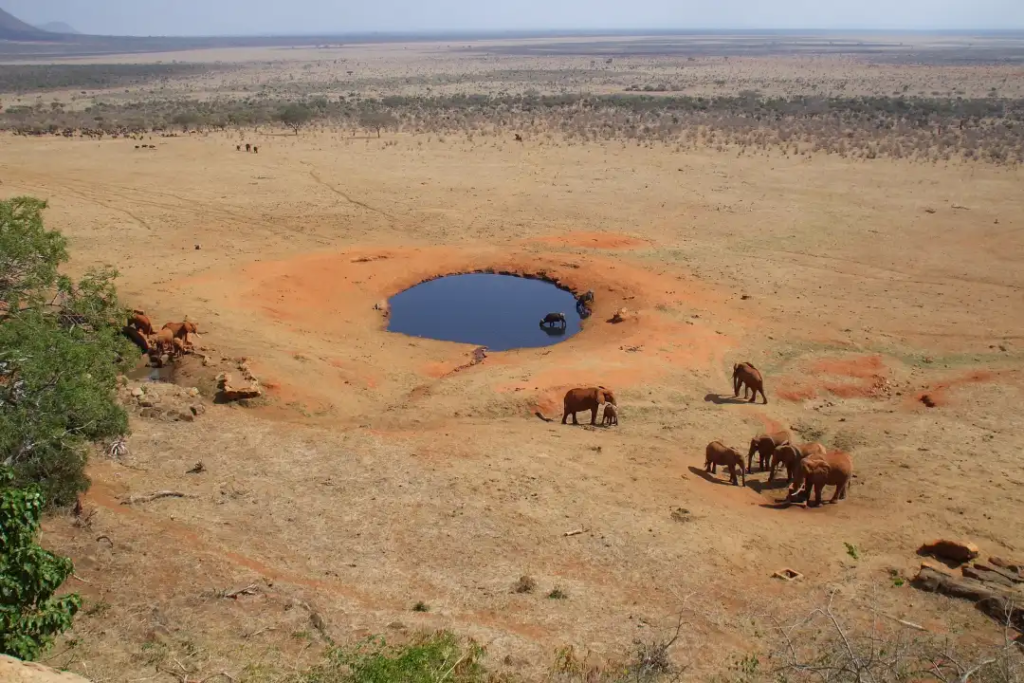The savanna ecosystem is a unique and diverse biome in various parts of the world. It is characterized by open grasslands with trees or shrubs scattered throughout.
It is commonly found in tropical and subtropical regions, such as parts of Africa, Australia, South America, and India. Savannas are known for their distinct seasonality, with wet and dry periods affecting the vegetation and wildlife.
Savannas are home to many plant and animal species adapted to survive in this specific environment. The grasslands provide:
- Abundant grazing opportunities for herbivores.
- Leading to diverse grazers like zebras.
- Antelopes.
- Bison populations.
Predators such as lions, cheetahs, and hyenas play a important role in the savanna food chain. The wealthy avian population includes various bird species, such as ostriches and eagles.

1. What are Abiotic Factors?
Abiotic factors refer to the non-living components of an ecosystem that shape its structure and influence the organisms within it. These factors are essential for the functioning and sustainability of the ecosystem.
Abiotic factors can be categorized into four main groups: climate, topography, water, and soil.
- Climate: The climate of a savanna ecosystem is characterized by distinct wet and dry seasons. The average annual temperature ranges between 20 to 30 degrees Celsius, with seasonal variations. The alternating damp and dry periods influence plant growth, animal behavior, and the overall dynamics of the ecosystem.
- Topography: The topography of a savanna includes various physical features like hills, valleys, and plains. Landscape diversity provides habitats for multiple species and influences factors such as water drainage and fire patterns.
- Water: Adequate water availability is vital for the survival of the savanna ecosystem. During the wet season, rainfall provides essential moisture for plant growth and replenishing water sources like rivers and lakes. In contrast, the dry season presents a challenge, as water becomes scarce, forcing plants and animals to adapt to survive with limited resources.
- Soil: Savannas have unique soil characteristics important in determining the vegetation composition and nutrient availability. The soils are often nutrient-poor, with limited organic matter, and are influenced by factors like drainage and mineral content. The soil type affects plant growth, water retention, and nutrient cycling.
2. Importance of Abiotic Factors in the Savanna Ecosystem:
Abiotic factors are fundamental to the functioning and stability of the savanna ecosystem. Here’s why they are essential:
a) Plant Adaptations: The climate and soil conditions in savannas shape the adaptations of plants. For example, grasses have evolved to withstand drought and fire, with deep root systems and the ability to regenerate quickly. Trees and shrubs in savannas have adapted to survive in low-nutrient soils and periodic water shortages. These adaptations contribute to the savanna ecosystem’s overall plant diversity and resilience.
b) Wildlife Habitat: The abiotic factors of savannas create diverse habitats for various animal species. The availability of water sources, such as rivers and watering holes, is important for supporting wildlife populations during the dry season. The topography provides preferred niches for different species, while the temperature and climate influence breeding cycles, migration patterns, and feeding behaviors.
c) Nutrient Cycling: The abiotic factors, particularly soil characteristics, influence nutrient cycling in the savanna ecosystem. The nutrient-poor soils promote the recycling of organic matter and the efficient use of available nutrients by plants. Decomposers and detritivores are vital in breaking down dead organic matter and recycling nutrients into the ecosystem.
d) Fire Regimes: Abiotic factors, especially the climate and vegetation structure, determine the fire regimes in savannas. Periodic fires help maintain the grassland structure, control invasive vegetation, and promote nutrient cycling. Fire-adapted plants have evolved strategies to survive and benefit from these recurrent fires, shaping the overall ecosystem dynamics.
Understanding the Five Abiotic Factors In Details
1. Climate and Precipitation Patterns in the Savanna Ecosystem
The savanna ecosystem is characterized by distinct climate and precipitation patterns that play a important role in shaping its unique vegetation and wildlife.

a. Rainfall Distribution and Seasonality:
The Savanna ecosystem is characterized by distinct rainfall distribution and seasonality patterns. The region experiences a seasonal climate with different wet and dry seasons.
The rainfall distribution in the savanna is highly variable and is influenced by factors such as land formations, altitude, and proximity to large water bodies. As a result, rainfall patterns can vary significantly across different regions of the savanna.
During the wet season, which generally occurs during the summer months, the savanna receives its highest levels of rainfall. This period of increased precipitation creates favorable conditions for the growth of grasses and other vegetation, resulting in leafy green landscapes.
The wet season is essential for the survival and reproduction of numerous species in the savanna, including herbivores and carnivores that rely on the abundant plant life.
In contrast, the dry season in the savanna is characterized by significantly less rainfall. This prolonged period of little to no precipitation creates a challenging environment for many organisms.
The absence of water limits plant growth, causing the grasses to dry out and become more flammable. Many herbivores migrate for water and food, while predators must adapt their hunting strategies to the changing conditions.
b. Temperature Range and Variations:
The savanna ecosystem experiences various temperatures throughout the year, varying day and night. The climate in the savanna is generally hot, although temperatures can vary depending on geographical location and altitude.
During the wet season, temperatures are typically high due to increased humidity and cloud cover. Daytime temperatures can range from 25 to 35 degrees Celsius (77 to 95 degrees Fahrenheit), creating a warm and often humid environment.
The abundance of rainfall during this period helps moderate temperatures and maintain relatively comfortable conditions for plants and animals.
In contrast, the dry season increases temperatures, especially during the day. With reduced cloud cover and less moisture in the air, the savanna experiences intense sunlight and higher evaporation rates.
Daytime temperatures can reach 40 degrees Celsius (104 degrees Fahrenheit) in some regions, making it exceptionally hot and challenging for organisms to cope. However, the temperature drops significantly during the night, offering some relief.
c. Droughts and Fires Influence:
Droughts and fires are influential factors in shaping the savanna ecosystem. The seasonality of the savanna, characterized by a long dry season, makes it prone to droughts. Droughts occur when the region experiences an extended period of below-average rainfall.

During droughts, the limited availability of water affects the overall productivity of the ecosystem. When plants cannot grow correctly, it severely limits or completely stops food availability for herbivores. This impacts the entire food chain because carnivores rely on herbivores.
Additionally, the dry season increases the risk of fires in the savanna. As vegetation dries out, it becomes highly flammable.
Fires in the savanna can occur naturally from lightning strikes or may be started by human activities such as agriculture or deliberate burning. While fires can be devastating, they also play a critical role in the savanna ecosystem.
Fires help to maintain open grasslands by preventing the growth of trees and woody shrubs. They also stimulate new growth and enable some plant species to release seeds that may only germinate after exposure to fire. Moreover, fires contribute to nutrient cycling by recycling nutrients into the soil.
2. Soil Composition and Quality in the Savanna Ecosystem
The soil composition and quality in the savanna ecosystem are essential factors influencing the health and productivity of this unique habitat.
Savannas are characterized by a combination of grasslands and scattered trees, and their soils play a vital role in supporting the various flora and fauna.

a. Soil Types and Characteristics in the Savanna Ecosystem:
The savanna ecosystem encompasses diverse soil types due to the varying environmental conditions across different regions. The following are some common soil types and their characteristics in the savanna:
- Alfisols: These soils are well-drained and typically found under grasslands in the savanna. They contain a high proportion of clay and organic matter, making them fertile and suitable for agriculture.
- Entisols: These are young and shallow soils that lack well-defined horizons. They often occur in areas with recent volcanic activity or where erosion is prevalent. Entisols are generally less fertile compared to other soil types.
- Oxisols: These highly weathered soils are characteristic of savannas in tropical regions. They are typically acidic, nutrient-poor, and have a low capacity to retain moisture. Despite their poor fertility, Oxisols can sustain vegetation adapted to nutrient-poor conditions.
- Vertisols: These clay-rich soils exhibit high shrink-swell properties when wet and dry. They can form deep cracks during dry periods and retain water during rainy seasons. Vertisols tend to have good fertility but require proper management to prevent erosion.
b. Nutrient Availability and Distribution:
In the savanna ecosystem, nutrient availability in the soil can vary depending on factors like climate, geology, and vegetation cover.
Nutrients essential for plant growth, such as nitrogen, phosphorus, potassium, and micronutrients, play a important role in supporting the diverse flora and fauna of the savanna.
Savanna soils typically have low natural fertility due to the leaching of nutrients caused by high rainfall and the rapid decomposition of organic matter in warm climates.
However, nutrient distribution can vary across different soil types. For instance, Alfisols tend to have better nutrient content compared to Oxisols.
Nutrient availability is also influenced by the high organic matter content present in the savanna ecosystem. Organic matter decomposition contributes to the release of nutrients, improving soil fertility in certain areas.
Additionally, interactions between plants and soil microbes play a vital role in nutrient cycling, further influencing nutrient availability and distribution.
c. Soil Moisture and Drainage:
Rainfall patterns and soil characteristics strongly influence soil moisture in the savanna ecosystem. The savanna typically experiences a distinct wet and dry season, leading to varying soil moisture conditions.
Different soil types exhibit various moisture-holding capacities and drainage properties. Like Vertisols, soils with a high clay content have good water-holding capacity but can be poorly drained due to their shrink-swell properties.
In contrast, like some Entisols, sandy soils drain rapidly and may have lower water-holding capacities.
The ability of savanna soil to retain moisture during the dry season is important for plant survival. The limited water availability during this period can lead to drought stress among plants and impact the overall savanna ecosystem dynamics.
Understanding the soil moisture characteristics and drainage patterns is essential for managing water resources in the savanna ecosystem, especially in regions where agriculture is practiced or where water availability is vital for wildlife and human populations.
3. Sunlight and Photoperiods in the Savanna Ecosystem
In the savanna ecosystem, sunlight and photoperiods play essential roles in shaping the environmental conditions, vegetation patterns, and animal behavior.
These factors shape the ecological dynamics of the entire ecosystem, influencing the behavior, distribution, and survival strategies of both plants and animals.
a. Length and Sunlight Intensity:
In the savanna ecosystem, day length and sunlight intensity play vital roles in shaping the behavior and adaptations of the organisms that inhabit it. As the savanna is characterized by distinct wet and dry seasons, the length of daylight and the intensity of sunlight vary throughout the year.
During the wet season, days are longer, with more daylight hours, providing ample sunlight for photosynthesis. Sunlight intensity is relatively high, promoting vegetation growth and supporting various plants.
This abundant sunlight also contributes to the warmth and moisture necessary for the proliferation of grasses, which form the foundation of the savanna food chain.
Conversely, during the dry season, day length becomes shorter, and sunlight intensity decreases. The reduced amount of sunlight limits photosynthetic activity and influences the behavior of both plants and animals.
Many plants have evolved strategies to cope with this seasonal change, such as entering dormancy or shedding leaves to conserve energy and moisture.
Some species, known as C4 plants, have specialized adaptations that enable them to capture and utilize sunlight efficiently, even under low light conditions.
b. Seasonal Changes and Plant Adaptations:
Seasonal changes in the savanna ecosystem significantly impact plant adaptations. During the wet season, abundant rainfall allows for the growth of a dense vegetation cover.
Many plants have developed adaptations to capitalize on this period, such as rapidly growing taller to outcompete neighboring plants for sunlight.
They may also invest energy in producing numerous seeds, taking advantage of the favorable conditions to maximize their chances of survival and reproduction.
In contrast, the dry season poses significant challenges for plants due to limited water availability and increased exposure to sunlight.
To survive these harsh conditions, some plants have developed adaptations to minimize water loss, such as deep root systems to access groundwater or the ability to store water in specialized tissues.
Others have evolved strategies to tolerate drought, including developing thick, waxy cuticles on leaves to reduce water evaporation or shedding leaves entirely to conserve resources.
c. Photosynthesis and Energy Capture:
Photosynthesis, the process by which plants convert sunlight into energy, is important for the functioning of the savanna ecosystem. Plants in the savanna, particularly grasses, have adapted to maximize their energy capture efficiency.
The abundance of sunlight in the savanna contributes to high rates of photosynthesis. However, the sun’s intensity can also be challenging, as excessive radiation can damage plant tissues.
To minimize this risk, many plants have developed adaptations like small, narrow leaves that reduce surface area and thereby limit exposure to intense radiation.
Moreover, the savanna is home to a group of C4 plants with particular biochemical pathways that enable them to utilize sunlight efficiently, even under high-light conditions. This adaptation allows C4 plants to thrive in open grasslands, where sunlight can be intense.
4. Topography and Drainage in the Savanna Ecosystem
The topography and drainage in the savanna ecosystem play an essential role in shaping its unique characteristics and supporting its diverse plant and animal life. Here are some key aspects to consider:
a. Landscape Features and Variation:
The savanna ecosystem is characterized by a unique combination of features and variations in its topography. It consists of vast grasslands dotted with scattered trees, and the landscape is typically flat or gently undulating with occasional hills, depressions, and rocky outcrops.
The presence of termite mounds is another distinctive feature that can be found in some areas. These landscape features contribute to the overall diversity and complexity of the ecosystem.
b. Water Flow and Erosion:
Water flow and erosion play important roles in shaping the savanna ecosystem. The generally flat terrain and sparse vegetation in savannas contribute to high surface runoff rates during rainfall.
It can result in the formation of temporary or seasonal streams and watercourses that enhance water drainage from the ecosystem.
However, the lack of dense vegetation makes the soil vulnerable to erosion. When heavy rainfall occurs, the water can easily wash away the exposed topsoil, leading to soil erosion.
Erosion can further alter the landscape by creating gullies and ravines or changing the course of streams. It is a natural process that contributes to the dynamism and diversity of the savanna ecosystem.
c. Impact on Plant and Animal Distribution:
The topography and drainage patterns significantly influence the distribution of plants and animals in the savanna ecosystem. Water availability plays a important role in determining the types and densities of plant life in different areas.
In low-lying areas or near water bodies, where there is better water access or retention, we may find more vegetation, including trees, shrubs, and grasses.
The availability of water and vegetation also influences the distribution of animals. As the primary producers, plants determine the suitability of an area for herbivores.
Areas with diverse vegetation, such as riverbanks or valleys, serve as prime habitats for various herbivorous animals. Predators, in turn, concentrate around areas that support abundant prey populations.
Furthermore, the topographic variations, such as hills, rocky outcrops, and termite mounds, provide additional niches for specific plant and animal species.
These microhabitats can support specialized vegetation communities and provide shelter, nesting sites, and vantage points for different animals.
5. Fire and Disturbance Regimes in the Savanna Ecosystem
Fire and disturbance regimes play an essential role in shaping and maintaining the structure and biodiversity of the savanna.
These fires are mostly ignited by lightning strikes or human activities such as agriculture or hunting. Savanna grasses are adapted to tolerate fire, often having underground rhizomes or other strategies to resprout after burning.
a. Role of Fire in Nutrient Cycling:
Fire plays a vital role in nutrient cycling in the savanna ecosystem. When a fire occurs, it releases nutrients stored in plant biomass into the soil as ash. These nutrients include carbon, nitrogen, phosphorus, and others.
The burning of organic matter also contributes to the breakdown of complex compounds into simpler forms, making them more readily available for uptake by plants and other organisms.
As a result, fire acts as a catalyst for nutrient release and recycling in the savanna ecosystem, maintaining soil fertility.
b. Fire Frequency and Intensity:
Fire frequency and intensity are essential in the savanna ecosystem, impacting vegetation composition and structure. The frequency of fires in savannas varies depending on climate, rainfall patterns, and human activities.
Frequent fires exert selective pressure on plant species, favoring those adapted to fire or have strategies to survive it, such as fire-resistant bark or underground storage organs that can resprout after fire.
However, fire occurs too frequently or with high intensity. In that case, it can have detrimental effects, leading to a decline in plant diversity and the dominance of fire-tolerant species that can outcompete others.
Balancing fire frequency and intensity is essential to maintaining a healthy and diverse savanna ecosystem.
c. Impacts on Species Diversity and Succession:
Fire is fundamental in shaping species diversity and successional processes in savannas. In areas where fires are naturally occurring, some plant species have evolved specific adaptations to fire, allowing them to resprout or germinate vigorously from seeds in the aftermath.
Fire opens up opportunities for new plant growth, providing space and nutrients for pioneer species to establish themselves. Over time, as fire recurs, different plant communities can develop through successional stages with increasing complexity.
However, if the fire is too frequent or intense, it can disrupt the successional processes, favoring certain species over others and reducing overall species diversity. Thus, the interaction between fire and succession is essential in maintaining a dynamic and diverse savanna ecosystem.
Human Impact on Abiotic Factors in the Savanna
Human activities have significantly impacted various abiotic factors in the savanna biome. Here are some key ways in which human actions have influenced this ecosystem:
- Climate Change: Human-induced climate change alters savanna regions’ temperature and precipitation patterns. Burning fossil fuels and deforestation contribute to releasing greenhouse gases, such as carbon dioxide, which trap heat in the atmosphere and cause global warming. It can lead to increased temperatures, changing rain patterns, and more frequent extreme weather events, all of which affect the abiotic conditions of the savanna.
- Land Use Changes: Human land use practices, particularly agriculture and urbanization, have transformed large savanna areas into farmland, grazing pastures, and human settlements. These activities result in deforestation, habitat destruction, and soil degradation, altering the composition and structure of the biome. Deforestation reduces the shade and moisture trees provide, leading to temperature, humidity, and nutrient cycling changes.
- Water Management: Developing irrigation systems, dams, and water diversion projects in savanna regions affects the natural hydrological cycle. Human activities alter river flows, disrupt natural flood patterns, and deplete groundwater resources. These alterations impact water availability for natural ecosystems and human communities, potentially leading to water scarcity and disturbances in the savanna biome’s water-dependent processes.
- Pollution: Industrial and agricultural activities release pollutants into the savanna’s air, soil, and water systems. Toxic chemicals, such as pesticides, fertilizers, and mining byproducts, can contaminate water bodies and soil, affecting their quality and the organisms that depend on them. These pollutants can impact abiotic factors, such as soil fertility, water chemistry, and air quality, altering the overall health of the savanna ecosystem.
- Invasive Species: Human activities, including international trade and travel, have introduced non-native species to savanna regions. Some species, known as invasive species, can outcompete native plants and animals for resources, disrupt natural ecosystem processes, and negatively impact abiotic factors. Invasive species can alter fire regimes, nutrient cycling, and vegetation dynamics, leading to changes in the savanna’s abiotic conditions.
Recognizing and mitigating these human impacts on abiotic factors in the savanna biome is essential to ensure the preservation and sustainable management of this unique and diverse ecosystem.
Conservation efforts, sustainable land use practices, and climate change mitigation strategies can help minimize the adverse effects and promote the long-term resilience of the savanna.
Conclusion:
In conclusion, the savanna ecosystem is influenced by a complex interplay of abiotic factors that shape its structure and functioning.
These abiotic factors include climate, soil properties, topography, and water availability. Together, they create a challenging but unique environment that supports a diverse array of plant and animal life.
The climate is one of the most significant abiotic factors in the savanna ecosystem. The distinct wet and dry seasons profoundly influence the distribution and abundance of species.
The extended dry season poses a considerable challenge for many organisms as water becomes scarce. However, the periodic rainfall during the wet season provides vital resources and triggers various ecological processes, such as plant growth and reproduction.
Frequently Asked Questions
The 5 key abiotic factors are climate, rainfall patterns, soil fertility, fire, and sunlight. Savannas have a tropical climate with distinct wet and dry seasons. Low soil fertility and seasonal water availability prevent dense forest growth. Frequent low-intensity fires also maintain the scattered tree savanna structure.
The tropical latitude climate provides high year-round solar radiation for plant growth. The distinct wet and dry seasons strongly shape savanna vegetation patterns and wildlife migration/aggregation cycles. Periodic drought is a natural disturbance factor.
Savanna soils are often highly weathered and leached of nutrients, with low organic matter. Porous soils and distinct wet/dry periods lead to rapid drainage, making savanna soils acidic, nutrient poor, and low in moisture retention. Termites help improve fertility.
Frequent low-intensity fires are part of the natural savanna ecosystem, occurring in the dry season. Fire suppresses tree seedlings, maintaining scattered tree cover. Grasses quickly regener
Sources and References:
- . “Sex, Hormones and Behavior.” Neuroscience & Biobehavioral Reviews, 1980, https://doi.org/10.1016/0149-7634(80)90004-4.
- non-living elements Archives – Science A Plus. https://scienceaplus.com/blog/tag/non-living-elements/
- Restoring a Tired and Challenged Lawn with Soil Testing | Home Expressions. https://www.homeexpressions.net/soil-test-a-necessity-to-restore-a-tired-and-challenged-lawn/
- . “COMPARATIVE ASSESSMENT OF TROPICAL RAINFOREST SOILS FORMED FROM DIFFERENT GEOLOGIC FORMATIONS IN SOUTHEASTERN NIGERIA.” Environment & Ecosystem Science, 2021, https://doi.org/10.26480/ees.01.2021.47.57.
- How Many Different Types & Styles of Martial Arts Are There?. https://dojolifehq.com/how-many-forms-of-martial-arts-are-there/
- Ecological Balance in Fire Preservation: Forest Management Explained – Strathclyde Fire Preservation Group. https://strathclydefirepreservationgroup.org/ecological-balance/
- Atsri, H. K.; Konko, Y.; Sanchez, A. C.; Abotsi, K. E.; Kokou, K. (2018). “Changes in the West African forest-savanna mosaic, insights from central Togo.” PLoS ONE 13(10):e0203999. Available at: https://doi.org/10.1371/journal.pone.0203999. (Accessed 15 January 2023).
- Pellegrini, A. F. A. (2016). “Nutrient limitation in tropical savannas across multiple scales and mechanisms.” Ecology 2016 Feb;97(2):313-24. Available at: https://doi.org/10.1890/15-0869.1. (Accessed 14 January 2023).
